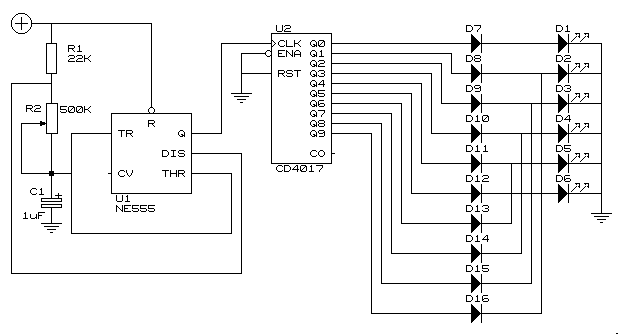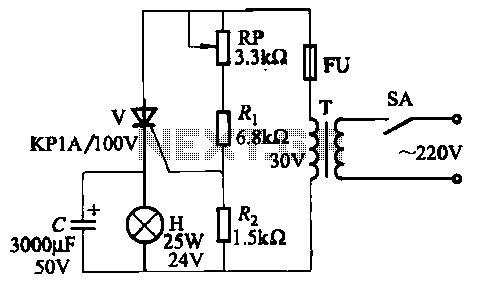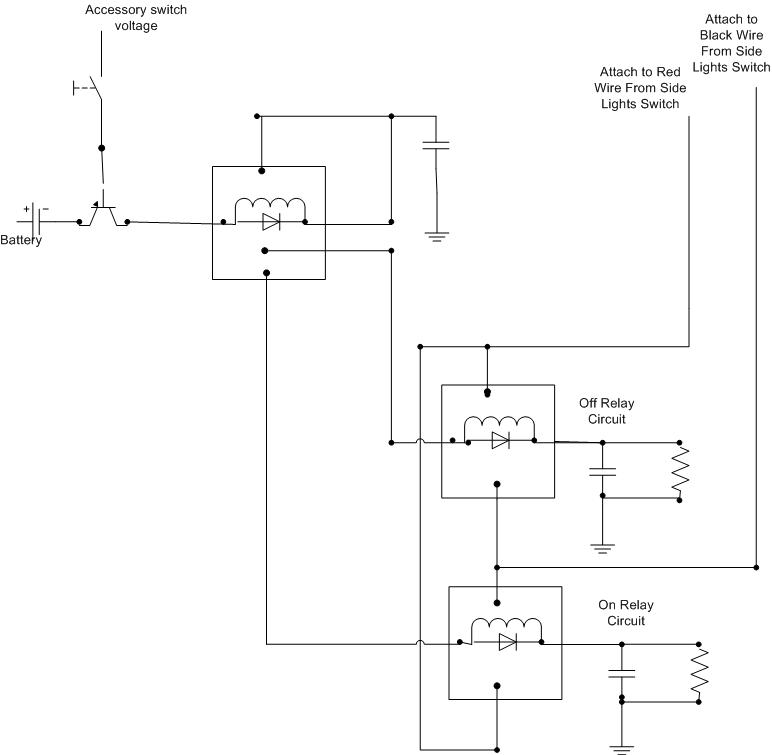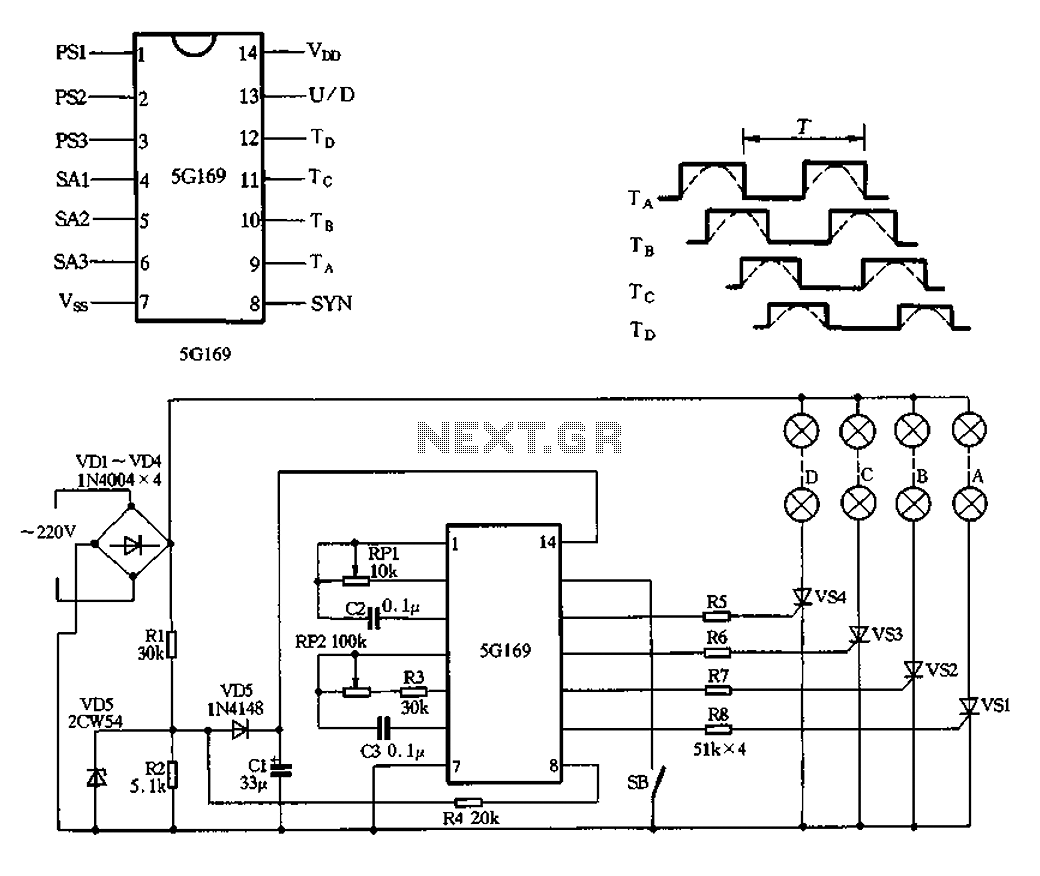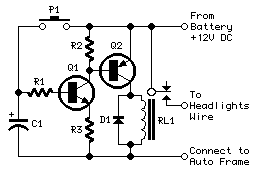
Lights On!

This circuit ensures that the car's lights will automatically activate when the engine is running, preventing the driver from forgetting to turn them on. The dipped beams and sidelights are engaged automatically, while the dipped beams turn off when the main beams are activated. The schematic diagram indicates that no special components are required. When the engine operates, the alternator produces a voltage exceeding 14 V. Diode D1 reduces this voltage by 5.6 V, which is then supplied to the base of transistor T1 through resistor R1. This results in T1 conducting, allowing amplified current to flow through resistor R3, the base of transistor T3, and diode D3 to ground. Consequently, T3 also conducts and activates relay Re1. If the driver engages the main beams, current flows through diode D2 and resistor R2 into the base of transistor T2, prompting it to conduct. This action decreases the voltage at the base of T3, causing T3 to cease conduction and the relay to deactivate. When the main beams are turned off, the system returns to its previous state, re-engaging the relay. The contacts of relay Re1 control the dipped beams and sidelights, while diodes D5 and D6 ensure that the sidelights illuminate whenever either the dipped or main beams are activated. Therefore, the sidelights will remain on as long as the engine is running, irrespective of the main beam status.
The circuit operates as follows: Upon starting the engine, the alternator generates a voltage greater than 14 V. This voltage is routed through diode D1, which drops it to 5.6 V, suitable for driving transistor T1. Resistor R1 limits the current into T1's base, ensuring it operates within safe parameters. Once T1 is activated, it allows current to flow through R3, providing a base current for T3. This results in T3 turning on, which energizes relay Re1, closing its contacts and powering the dipped beams and sidelights.
When the driver activates the main beams, current flows through diode D2 and resistor R2, energizing transistor T2. This action decreases the voltage at T3's base, causing it to turn off and de-energizing relay Re1, which in turn extinguishes the dipped beams. The system is designed to revert to its original state when the main beams are switched off, allowing the dipped beams and sidelights to operate once again.
The inclusion of diodes D5 and D6 ensures that the sidelights are illuminated whenever either set of beams is engaged, providing a safety feature that enhances visibility. This design is straightforward, requiring only common components, which simplifies installation and reduces cost while ensuring reliable operation of the vehicle's lighting system.This circuit ensures that you will never again forget to switch on the lights of your car. As soon as the engine is running, the dipped beams and the sidelights are automatically switched on. The circuit also causes the dipped beams to be extinguished as soon as the main beams are switched on. As you can see from the schematic diagram, no special components are needed. When the engine is running, the alternator will generate a voltage of more than 14 V. Diode D1 reduces this voltage by 5. 6 V and passes it to the base of T1 via R1. Due to the resulting current, T1 conducts. The amplied current‚ows via R3, the base of T3 and D3 to ground. This causes T3 to also conduct and energize relay Re1. If the driver now switches on the main beams, a current‚ows through D2 and R2 into the base of T2, causing this transistor to conduct. As a result, the voltage on the base of T3 drops, causing T3 to cut off and the relay to drop out. When the main beams are switched off, the previous situation is restored, and the relay again engages.
The dipped beams and the sidelights are switched by the contacts of relay Re1. Diodes D5 and D6 ensure that the sidelights are illuminated if either the dimmed beams or the main beams are switched on. In practice, this means that the sidelights will be on whenever the engine is running, regardless of whether the main beams are switched on.
🔗 External reference
The circuit operates as follows: Upon starting the engine, the alternator generates a voltage greater than 14 V. This voltage is routed through diode D1, which drops it to 5.6 V, suitable for driving transistor T1. Resistor R1 limits the current into T1's base, ensuring it operates within safe parameters. Once T1 is activated, it allows current to flow through R3, providing a base current for T3. This results in T3 turning on, which energizes relay Re1, closing its contacts and powering the dipped beams and sidelights.
When the driver activates the main beams, current flows through diode D2 and resistor R2, energizing transistor T2. This action decreases the voltage at T3's base, causing it to turn off and de-energizing relay Re1, which in turn extinguishes the dipped beams. The system is designed to revert to its original state when the main beams are switched off, allowing the dipped beams and sidelights to operate once again.
The inclusion of diodes D5 and D6 ensures that the sidelights are illuminated whenever either set of beams is engaged, providing a safety feature that enhances visibility. This design is straightforward, requiring only common components, which simplifies installation and reduces cost while ensuring reliable operation of the vehicle's lighting system.This circuit ensures that you will never again forget to switch on the lights of your car. As soon as the engine is running, the dipped beams and the sidelights are automatically switched on. The circuit also causes the dipped beams to be extinguished as soon as the main beams are switched on. As you can see from the schematic diagram, no special components are needed. When the engine is running, the alternator will generate a voltage of more than 14 V. Diode D1 reduces this voltage by 5. 6 V and passes it to the base of T1 via R1. Due to the resulting current, T1 conducts. The amplied current‚ows via R3, the base of T3 and D3 to ground. This causes T3 to also conduct and energize relay Re1. If the driver now switches on the main beams, a current‚ows through D2 and R2 into the base of T2, causing this transistor to conduct. As a result, the voltage on the base of T3 drops, causing T3 to cut off and the relay to drop out. When the main beams are switched off, the previous situation is restored, and the relay again engages.
The dipped beams and the sidelights are switched by the contacts of relay Re1. Diodes D5 and D6 ensure that the sidelights are illuminated if either the dimmed beams or the main beams are switched on. In practice, this means that the sidelights will be on whenever the engine is running, regardless of whether the main beams are switched on.
🔗 External reference
